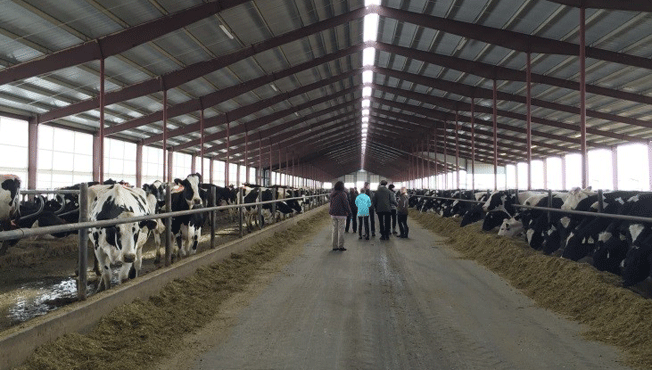On Monday I had the opportunity to experience a new-to-me foodie activity – visiting a dairy to learn firsthand how our milk goes from cow to grocery store. Dairy MAX organized this event in conjunction with some of my co-workers for a day-long educational experience and our group had around 22 people who participated in the tour.
We arrived at Lost Creek Dairy (located in Roggen, Colorado) around 9:30 in the morning and were immediately greeted by one of the owners, Tammie, who gave us some background information. They have around 40 employees on staff and run a 24/7 operation! With around 4,000 cows, about 100 are milked at a time. After a lighthearted warning about watching for “splatters”, we were able to go inside where all of the magic happens.
One thing that fascinated my nerdy techy self is the computer automation of the whole process. As you can see, the cows have color on their backs which symbolizes one of the following statuses: need for artificial insemination, pregnant, or just gave birth. There is also a chip in each of the cow’s ears for easy tracking of all sorts of important information.
Some concerns about dairy farming were naturally addressed throughout the tour, as the audience was primarily made up of registered dietitians. For instance:
- On antibiotic use – cows are treated with antibiotics if they have mastitis, but the milk is kept separate until it tests “clear” of any trace amount. There are also additional checks in place and if any milk fails the antibiotic test once shipped, it is dumped at the expense of the dairy. For this reason you don’t have to be concerned about getting antibiotics in milk that you purchase at the store. By the time it reaches shelves, it has passed many different quality control measures.
- On the treatment of cows – per the owner, their cows are “treated like princesses” and actually have their own dairy nutritionist! It would be interesting to learn more about the optimal diet for cows (adequate protein after birth was one component mentioned). Cows are able to graze freely but on the day that we visited, the property was extra muddy and wet due to the recent snow storm so for this reason, they were kept inside this half-mile long barn. You can see that the feed is laid along the sides so cows have access to it at all times and they basically just roam around, eating at their leisure.
- On quality – the milk from Lost Creek is sent to a Kroger plant for processing and reportedly they have very strict standards for freshness and quality (more testing and regulations). This is where pasteurization takes place to ensure a safe product.
All things considered, it was clear to me that the employees of Lost Creek take great pride in what they do and happy, healthy cows are a top priority for them.
Afterwards, our group joined up with some more dietitians and we were lucky enough to attend a presentation by Dayle Hayes, a highly-sought after Montana-based registered dietitian who specializes in school nutrition. The title of the talk was, “Deciphering Recent Dairy Research: Common Milk Myths and the Facts You Need at WIC.” She did a wonderful job catering the presentation, as many in the audience were WIC dietitians, but also including very recent articles (one published on that very morning actually!) outlining the importance of re-evaluating the effect of milk fat on health outcomes.
Is there something to this new full-fat dairy trend? For now, it seems like more research is warranted. Either way, I think we can all agree with the following:
About the Guest Author
Leanne Ray, RDN
Leanne Ray, RDN is a registered dietitian based out of Denver, Colorado. She loves cooking and helping others learn how to cook great tasting food that fits into a healthy and balanced lifestyle. Learn more about Leanne on her website.




